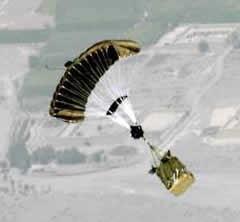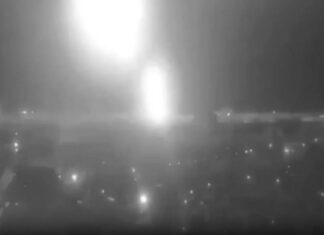The largest error component for release point calculation is the wind estimate. Former practice used to rely on wind models based on a weather forecast, rather than the real wind conditions encountered through the actual para descend. Fortunately, such updated models can now be acquired in near real-time, by wind measurement ‘dropsonde sensors’. These probes are dropped from the aircraft prior to cargo release, by monitoring their position via GPS. Wind forces and direction can be tracked, automatically updating the release point, altitude and flight plan for each of the guided cargo systems,thus literally steering each cargo pallet to its designated target. When released from 25,000 feet (7,620 m’), these systems dramatically improve the accuracy of aerial delivery, by landing an unguided cargo pallet within 400 meters of the designated drop point.
The integration of the ram-air technology and auto-piloting capability is introducing new delivery systems that are vanguard for a revolution in the way land forces can be deployed and supplied in the battlezone.
 The Rapid Aerial Delivery technique, also known as the ‘Screamer’, produced by Strong Enterprises, utilizes a small steerable ram-air drogue (RAD) parachute to drop the cargo at a 100mph (44.7 m/sec) rate of descend, navigating to a predetermined location where the main conventional parachute is deployed for the final descent. This capability enables stand-off delivery of existing cargo configurations from off-set positions. Taking advantage of the ram-air drogue technique significantly increases the rate of descent of the cargo over conventional drops yet controls the stability and lateral movement of cargo. It also reduces the flying time, when the cargo and ground troops are exposed, and minimizes wind drift effect and permitting more precise targeting.
The Rapid Aerial Delivery technique, also known as the ‘Screamer’, produced by Strong Enterprises, utilizes a small steerable ram-air drogue (RAD) parachute to drop the cargo at a 100mph (44.7 m/sec) rate of descend, navigating to a predetermined location where the main conventional parachute is deployed for the final descent. This capability enables stand-off delivery of existing cargo configurations from off-set positions. Taking advantage of the ram-air drogue technique significantly increases the rate of descent of the cargo over conventional drops yet controls the stability and lateral movement of cargo. It also reduces the flying time, when the cargo and ground troops are exposed, and minimizes wind drift effect and permitting more precise targeting.
The ability to precisely drop cargo from a higher and safer altitude substantially increases the safety of the aircraft as well. Since the loads can steer themselves, the aircraft can fly to an area over the drop zone to release the loads, as opposed to a single point- offering substantially lower risk to aircraft over the drop zone. In addition to accuracy, JPADS allows different bundles to steer themselves to more than one drop zone.
Read additional parts of this article:



















